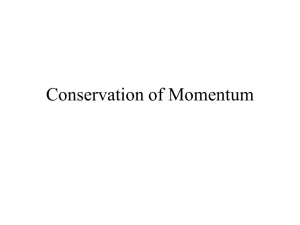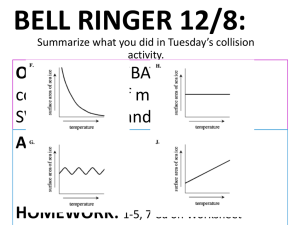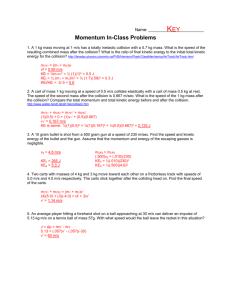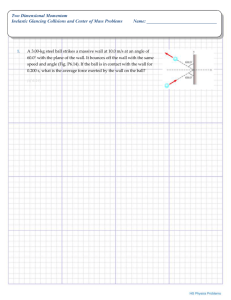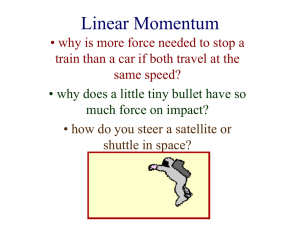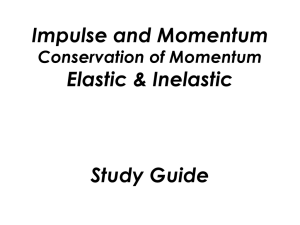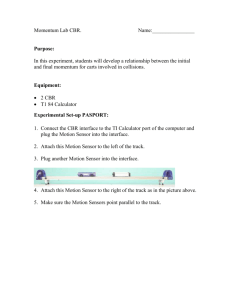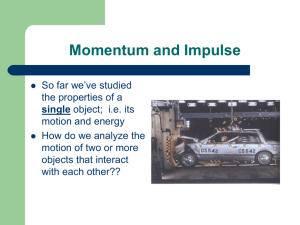File - PHYSICS AP/DUAL
advertisement
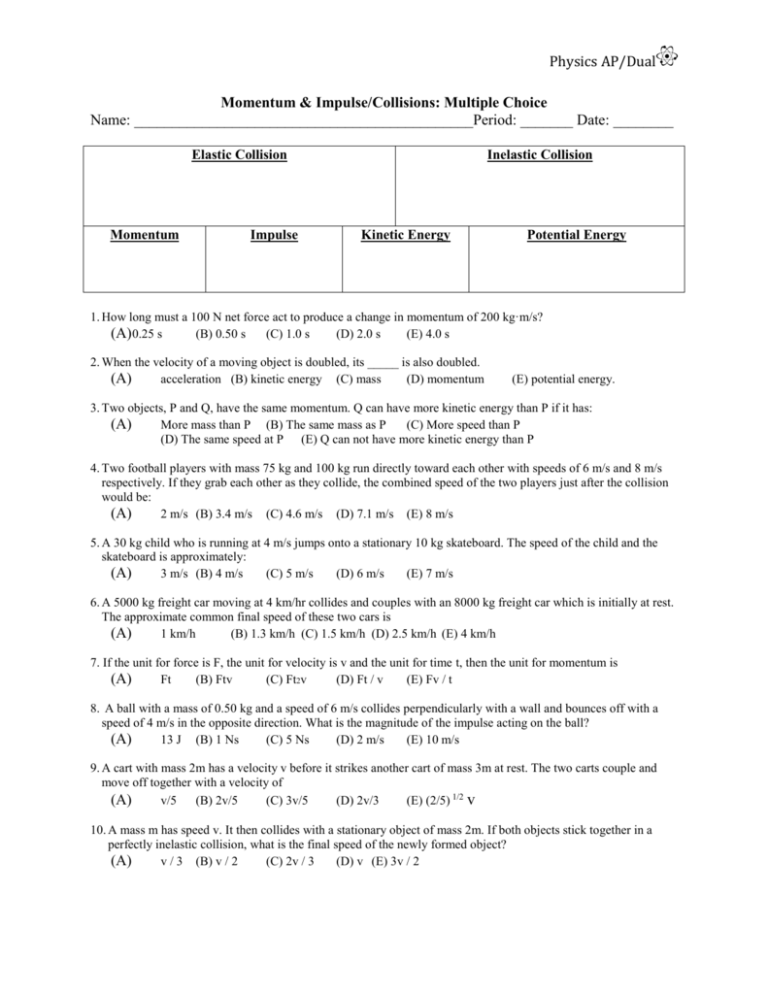
Physics AP/Dual Momentum & Impulse/Collisions: Multiple Choice Name: _____________________________________________Period: _______ Date: ________ Elastic Collision Momentum Impulse Inelastic Collision Kinetic Energy Potential Energy 1. How long must a 100 N net force act to produce a change in momentum of 200 kg·m/s? (A) 0.25 s (B) 0.50 s (C) 1.0 s (D) 2.0 s (E) 4.0 s 2. When the velocity of a moving object is doubled, its _____ is also doubled. (A) acceleration (B) kinetic energy (C) mass (D) momentum (E) potential energy. 3. Two objects, P and Q, have the same momentum. Q can have more kinetic energy than P if it has: (A) More mass than P (B) The same mass as P (C) More speed than P (D) The same speed at P (E) Q can not have more kinetic energy than P 4. Two football players with mass 75 kg and 100 kg run directly toward each other with speeds of 6 m/s and 8 m/s respectively. If they grab each other as they collide, the combined speed of the two players just after the collision would be: (A) 2 m/s (B) 3.4 m/s (C) 4.6 m/s (D) 7.1 m/s (E) 8 m/s 5. A 30 kg child who is running at 4 m/s jumps onto a stationary 10 kg skateboard. The speed of the child and the skateboard is approximately: (A) 3 m/s (B) 4 m/s (C) 5 m/s (D) 6 m/s (E) 7 m/s 6. A 5000 kg freight car moving at 4 km/hr collides and couples with an 8000 kg freight car which is initially at rest. The approximate common final speed of these two cars is (A) 1 km/h (B) 1.3 km/h (C) 1.5 km/h (D) 2.5 km/h (E) 4 km/h 7. If the unit for force is F, the unit for velocity is v and the unit for time t, then the unit for momentum is (A) Ft (B) Ftv (C) Ft2v (D) Ft / v (E) Fv / t 8. A ball with a mass of 0.50 kg and a speed of 6 m/s collides perpendicularly with a wall and bounces off with a speed of 4 m/s in the opposite direction. What is the magnitude of the impulse acting on the ball? (A) 13 J (B) 1 Ns (C) 5 Ns (D) 2 m/s (E) 10 m/s 9. A cart with mass 2m has a velocity v before it strikes another cart of mass 3m at rest. The two carts couple and move off together with a velocity of (A) v/5 (B) 2v/5 (C) 3v/5 (D) 2v/3 (E) (2/5) 1/2 v 10. A mass m has speed v. It then collides with a stationary object of mass 2m. If both objects stick together in a perfectly inelastic collision, what is the final speed of the newly formed object? (A) v / 3 (B) v / 2 (C) 2v / 3 (D) v (E) 3v / 2 11. A Freight car is moving freely along a railroad track at 7 m/s and collides with a tanker car that is at rest. After the collision, the two cars stick together and continue to move down the track. What is the magnitude of the final velocity of the cars if the freight car has a mass of 1200 kg and the tanker car has a mass of 1600 kg? (A) 0 m/s (B) 1 m/s (C) 3 m/s (D) 4 m/s (E) 6 m/s 12. A 50 kg skater at rest on a frictionless rink throws a 2 kg ball, giving the ball a velocity of 10 m/s. Which statement describes the skater’s subsequent motion? (A) 0.4 m/s in the same direction as the ball. (B) 0.4 m/s in the opposite direction of the ball (C) 2 m/s in the same direction as the ball (D) 4 m/s in the same direction as the ball (E) 4 m/s in the opposite direction of the ball 13. The net force on a rocket with a weight of 1.5 x 10 4 N is 2.4 x 104 N. How much time is needed to increase the rockets speed from 12 m/s to 36 m/s near the surface of the Earth at takeoff? (A) 0.62 s (B) 0.78 s (C) 1.5 s (D) 3.8 s (E) 15 s 14. An arrow is shot through an apple. If the 0.1 kg arrow changes speed by 10 m/s during the collision (from 30 m/s to 20 m/s) and the apple goes from rest to a speed of 2 m/s during the collisions, then the mass of the apple must be (A) 0.2 kg (B) 0.5 kg (C) 0.8 kg (D) 1 kg (E) 2 kg 15. A railroad flatcar of mass 2,000 kilograms rolls to the right at 10 meters per second and collides with a flatcar of mass 3,000 kilograms that is rolling to the left at 5 meters per second. The flatcars couple together. Their speed after the collision is (A) 1 m/s (B) 2.5 m/ s (C) 5 m/ s (D) 7 m/ s (E) 7.5 m/ s 16. A railroad car of mass m is moving at speed v when it collides with a second railroad car of mass M which is at rest. The two cars lock together instantaneously and move along the track. What is the speed of the cars immediately after the collision? (A) v/2 (B) mv/M (C) Mv/m (D) (m + M )v/m (E) mv/(m+M) Physics AP/Dual Physics AP/Dual Problem 1 Solution J=Ft Use J=Δp 200=100t t=200/100=2s 2 Answer D D Since p=mv, by doubling v you also double p 3 Since the momentum is the same, that means the quantity m 1v1 = m2v2. This means that the mass and velocity change proportionally to each other so if you double m 1 you would have to double m2 or v2 on the other side as well to maintain the same momentum. Now we consider the energy formula KE= ½ mv2 since the v is squared, it is the more important term to increase in order to make more energy. So if you double the mass of 1, then double the velocity of 2, you have the same momentum but the velocity of 2 when squared will make a greater energy, hence we want more velocity in object 2 to have more energy. C 4 Perfect inelastic collision. m1v1 + m2v2 = (m1+m2)v (75)(6) + (100)(–8) = (175) vf Vf=2m/s A 5 Perfect inelastic collision. (v2=0m/s) m1v1 = (m1+m2) vf (30)(4) = (40)vf A Vf=3m/s 6 Perfect inelastic collision. m1v1 = (m1+m2) vf (5000)(4) = (13000)vf (v2=0m/s) C Vf=1.5km/h 7 Momentum is equivalent to impulse which is Ft A 8 Use J=Δp J = m(v – vo) J = (0.5)(– 4 – 6) J=5Ns Perfect inelastic collision. m1v1 = (m1+m2) vf (2m)(v) = (5m) vf C 9 B 2v/5=vf 10 11 Perfect inelastic collision (v2=0m/s) m1v1 = (m1+m2) vf (m)(v) = (3m) vf v/3= vf Perfect inelastic collision (v2=0m/s) m1v1 = (m1+m2) vf (1200)(7) = (2800)vf Vf=3m/s A C 12 13 Explosion. Vo=0m/s (m1+ m2)vo = m1v1 + m2v2 0 = (50)(v1) + (2)(10) v1=-0.4 (negative indicates to the left) Use J=Δp Ft = m(vf – vo) B C note: since m is not given we will plug in Fg / g with g as 10 to be used in the impulse equation. (24000)(t) = (15000 / 10m/s2)(36–12) t=1.5s 14 Momentum conservation. (v2=0m/s) B pbefore = pafter m1v1+ m2v2 = m1v1’ + m2v2’ (0.1)(30) = (0.1)(20)+(m 2)(2) m2=0.5kg 15 Perfect inelastic collision. m1v1i+ m2v2 =(m1+m2)vf (2000)(10) + (3000)(–5) = (5000) vf Vf=1m/s A 16 Perfect inelastic collision. m1v1 = (m1+m2) vf (m)(v) = (m+M) vf Vf= mv/(m+M) E (v2=0m/s)

